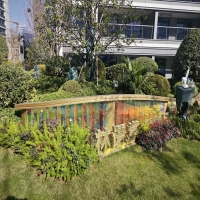Welcome to the website for landscape facilities products and knowledge.
What are the potential drawbacks or limitations of the Landscape Round Table in certain environments?
While Landscape Round Tables have gained popularity as collaborative tools in various professional settings, their implementation often reveals significant limitations that can undermine their effectiveness. One primary concern is spatial inefficiency - these circular arrangements typically require more floor space than traditional rectangular setups, making them impractical for compact offices or rooms with fixed dimensions. The very geometry that promotes equality can also create physical barriers to communication, as participants must constantly turn their heads or reposition their bodies to maintain eye contact with different speakers.
Another critical drawback emerges in larger groups where the round table format struggles with scalability. When participant numbers exceed eight to ten individuals, the intimate circle transforms into an unwieldy arrangement where voices from the opposite side become difficult to hear and visual cues are lost. This acoustic and visual degradation frequently leads to subgroup formation, effectively defeating the purpose of unified discussion. The presumed equality of participation often proves illusory in practice, as dominant personalities can still monopolize conversations while introverted team members may become visually exposed and psychologically pressured in the equal-visibility setup.
Environmental constraints further compound these issues. In technology-rich meeting environments, the circular configuration creates challenges for integrating presentation equipment, video conferencing systems, and shared displays. The absence of a clear "front" of the room disrupts conventional presentation dynamics and can create awkward sightline issues for visual materials. Additionally, the fixed nature of many round tables limits flexibility for different meeting types, unable to easily reconfigure for presentations, workshops, or breakout sessions that might occur within the same gathering.
Perhaps most significantly, the round table's symbolic equality can mask underlying power dynamics and decision-making processes. While physically equal positioning suggests democratic participation, organizational hierarchies and influence patterns often persist unchanged. This disconnect between physical arrangement and social reality can create frustration when the format promises collaboration but delivers conventional outcomes. Furthermore, the informal atmosphere may inadvertently reduce documentation rigor and action item accountability that more structured meeting formats naturally enforce.
In specialized environments such as educational institutions, research laboratories, or legal settings, these limitations become particularly pronounced. The format may conflict with pedagogical needs for instructor visibility, laboratory safety protocols requiring clear line-of-sight to equipment, or legal proceedings demanding precise seating arrangements. Even in corporate environments, the investment in round table furniture often fails to deliver proportional returns in meeting productivity, particularly when compared to more flexible seating arrangements that can adapt to different collaborative needs.
The physical constraints extend to accessibility considerations as well. Wheelchair users and individuals with mobility challenges may find navigating the continuous circular structure more difficult than conventional table arrangements with clear pathways. The lack of defined edges and corners can also create orientation difficulties for visually impaired participants who often use table geometry for spatial reference during discussions.
While Landscape Round Tables offer theoretical benefits for collaborative discourse, organizations must carefully weigh these limitations against their specific environmental constraints, group dynamics, and meeting objectives. The romantic ideal of round table collaboration often clashes with the practical realities of space, technology, human behavior, and organizational structure that ultimately determine meeting effectiveness.
Related search:

Recommendation
Metal and acrylic color-changing combined curtain wall for large-scale public landscape facilities